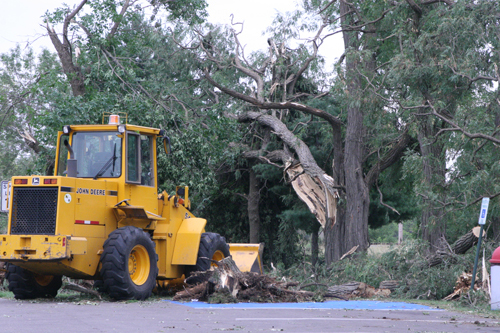By Katie Rousonelos, Wisconsin Emergency Management – Public Information Officer; Katie.Rousonelos@widma.gov or 608-242-3239
 Severe weather can destroy Wisconsin communities and result in hefty cleanup costs. While public works budgets and insurance may cover some expenses, the costs might exceed available funding.
Severe weather can destroy Wisconsin communities and result in hefty cleanup costs. While public works budgets and insurance may cover some expenses, the costs might exceed available funding.
Federal funding could help, but qualifying for a federally declared disaster can be difficult. The Federal Emergency Management Agency Public Assistance program funds state, tribal, territorial and local governments. It covers costs for debris removal, life-saving emergency protective measures and restoring public infrastructure. To get this funding, damage at the state level must reach at least $1.84 per member of the population. At the county level, it is $4.60 per person. Those numbers are adjusted every year and are based on census data.
If federal funding is not possible, local and county governments can turn to the state for help. The Wisconsin Disaster Fund (WDF) can cover certain public sector costs. Wisconsin Emergency Management (WEM), a division within the Wisconsin Department of Military Affairs, oversees the program. It returns up to 70% of the costs of debris removal, emergency protective measures or emergency road and bridge repairs.
“In many communities, rebuilding would be significantly delayed without the WDF to help reimburse them,” said Ruhamah Bauman, WEM Bureau of Operations and Planning Support director. “This program has proven to help communities recover after weathering the storm.”
Requests for WDF payments are sent to WEM through county and tribal emergency management offices. Each step in the process must be done within specific time periods.
- Within 72 hours of the start of the event, it is recommended that initial damage estimates be submitted to WEM.
- Within 30 days from the end of the incident, a form identifying possible applicants is due.
- Within 60 days of an incident’s end, applications and damage assessments are due.
The WDF does not cover individuals, businesses or the agricultural sector. It also does not cover costs associated with snowstorms or damage covered by insurance. The program is limited to local governments, including counties, municipalities and tribes. Publicly owned electric cooperatives can also apply.
The WDF has helped many communities in recent years. Projects include debris removal from roads caused by severe winter ice and strong winds in Rusk County in 2023 and repairing flood-damaged roads in Iowa County in 2022.
